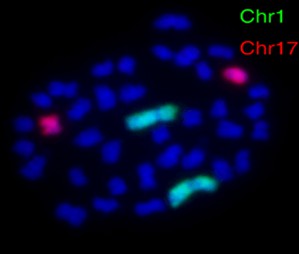Whole Chromosome Painting Probes for FISH
Fluorescence in situ hybridization (FISH) is a vital molecular cytogenetic technique in genetic research and clinical diagnosis. It allows the visualization of specific DNA sequences within chromosomes, aiding in detecting chromosomal abnormalities and genetic disorders. Whole chromosome painting probes play a crucial role in FISH by enabling the simultaneous visualization of entire chromosomes, providing valuable insights into the structural organization and behavior of chromosomes.

What are Whole Chromosome Painting Probes?
Whole chromosome painting probes are molecular tools designed to target and hybridize to the entire length of a specific chromosome. These probes are labeled with fluorescent dyes, allowing for the visualization and identification of the targeted chromosome within a cell nucleus. The development of whole chromosome painting probes involves various methods, including chromosome microdissection, degenerate oligonucleotide-primed polymerase chain reaction (DOP-PCR), and fluorescence-activated chromosome sorting (FACS).
Advantages of Whole Chromosome Painting Probes for FISH
- Comprehensive chromosomal analysis. Unlike traditional banding techniques, whole chromosome painting probes offer a comprehensive view of entire chromosomes, enabling the simultaneous visualization of chromosomal aberrations and structural rearrangements. This comprehensive analysis enhances the efficiency and accuracy of cytogenetic investigations, particularly in complex karyotypes and mosaicism.
- High sensitivity and specificity. Whole chromosome painting probes demonstrate high sensitivity and specificity in detecting chromosomal abnormalities, making them invaluable in both research and clinical settings. The precise targeting of entire chromosomes minimizes the risk of false-positive or false-negative results, ensuring the reliability of FISH-based analyses.
- Enhanced throughput and efficiency. Using whole chromosome painting probes streamlines the FISH workflow by simplifying the process of identifying and analyzing multiple chromosomal regions in a single experiment. This improved throughput and efficiency are particularly advantageous in high-volume cytogenetics laboratories, where rapid and accurate results are essential for patient care and clinical decision-making.
Whole Chromosome Painting Probes in Cytogenetics
Whole chromosome painting probes are used to detect chromosomal abnormalities such as aneuploidy (the presence of an abnormal number of chromosomes), translocations (rearrangements of parts between nonhomologous chromosomes), and deletions.
Whole Chromosome Painting Probes in Cancer Research
In the field of oncology, whole chromosome painting probes have emerged as indispensable tools for investigating chromosomal aberrations in cancer cells. By using these probes in FISH analysis, researchers can identify specific chromosomal changes associated with various types of cancer, aiding in tumor classification, prognostic assessment, and treatment decision-making.
Whole Chromosome Painting Probes in Genetic Disorders Identification
Whole chromosome painting probes also find extensive applications in the diagnosis of genetic disorders such as Down syndrome, Turner syndrome, and Klinefelter syndrome. Through FISH analysis with chromosome-specific painting probes, researchers can accurately detect aneuploidies and other chromosomal abnormalities.
Creative Bioarray Relevant Recommendations
Creative Bioarray has a full range of DNA probe libraries that use fluorescently labeled specific chromosomes (whole chromosome, specific chromosome arm, or chromosome fragments).
| Cat. No. | Product Name |
| FWCP-01 | WCP 1 FISH Probe |
| FWCP-02 | WCP 2 FISH Probe |
| FWCP-03 | WCP 3 FISH Probe |
| FWCP-04 | WCP 4 FISH Probe |
| FWCP-05 | WCP 5 FISH Probe |
| FWCP-06 | WCP 6 FISH Probe |
| FWCP-07 | WCP 7 FISH Probe |
| FWCP-08 | WCP 8 FISH Probe |
| FWCP-09 | WCP 9 FISH Probe |
| FWCP-10 | WCP 10 FISH Probe |
| FWCP-23 | WCP X FISH Probe |
| FWCP-24 | WCP Y FISH Probe |
View our full range of whole chromosome painting probes and find what you need!